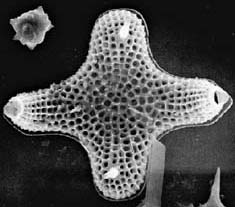Introduction to Bacillariophyta (The Diatoms)
Life inside a glass box. . .




The Bacillariophyta are the diatoms. With their exquisitely beautiful silica shells, or frustules such as that of Odontella shown above at right, diatoms are among the loveliest microfossils. They are also among the most important aquatic microorganisms today: they are extremely abundant both in the plankton and in sediments in marine and freshwater ecosystems, and because they are photosynthetic they are an important food source for marine organisms. Some may even be found in soils or on moist mosses.
Diatoms have an extensive fossil record going back to the Cretaceous; some rocks are formed almost entirely of fossil diatoms, and are known as diatomite or diatomaceous earth. These deposits are mined commercially as abrasives and filtering aids. Analysis of fossil diatom assemblages may also provide important information on past environmental conditions.




For more information on diatoms and how they are used in environmental reconstruction, check out the Paleolimnology and Diatom Home Pages maintained by P. Roger Sweets at Indiana University, or visit the Algal Microscopy and Image Digitization Home Page at Bowling Green State University for many images of diatoms.
You might also want to visit the Diatom Collections of the California Academy of Sciences, including databases on diatom genera and literature.
A general article on diatoms (15 Sep 1997) is available from the Mining Company.


